- Highlights
- How to reach Annapurna Base Camp?
- How difficult is the Annapurna Base Camp Trek?
- Permits: What permits are necessary for ABC Trek?
- Travel insurance for ABC Trek: What should it cover?
- Best time to Trek Annapurna Base Camp
- Trek Itinerary & Duration:
- Cost:
- What to Pack?
- Accommodation and Food
- Cultural Experiences:
- Final Note
The Annapurna Base Camp lies at the base of the tenth-highest mountain in the world, the Annapurna I (8091m). It is the final destination of the Annapurna Base Camp Trek, one of the most popular treks in the Nepal Himalayas. Located at an altitude of 4130m, the Annapurna Base Camp can be reached via a foot trail running across lush forests, traditional Gurung villages, terraced fields, Himalayan rivers, and hot springs. The ABC Trek is one of the shortest and most doable high-altitude treks in Nepal.
Easier than the Everest Base Camp Trek and with an easily accessible route, the Annapurna Base Camp Trek is a favorite among tourists trekking for the first time in Nepal. Depending on the route one chooses, the trek can last anywhere between ten to five days.
The shortest route to ABC is the one from Kimchi and Ghandruk. If you are fit enough, you can complete the Annapurna Base Camp Trek in five days via this route. The route from Nayapul or Tikhedhunga takes longer (around 9-10 days), but the experience is richer as one gets to trek via the beautiful rhododendron forests of Ghorepani and visit the Himalayan viewpoint of Poon Hill. Starting your trek from Kande takes you past the beautiful Australian Camp and the rarely visited Gurung villages of Tolka, Pothana, and Landruk.
The major stops en route to Annapurna Base Camp are Ghandruk, Jhinu Danda, Chhomrong, Sinuwa, Bamboo, Dovan, Himalaya, Deurali, Machapucchre Base Camp, and finally, Annapurna Base Camp.
Highlights
- Annapurna Base Camp is located under the shadows of the magnificent Annapurna Massif. One can enjoy close-up views of Annapurna I (the tenth highest mountain in the world), Annapurna II, III and IV, Annapurna South, Hiunchuli, Gangapurna, Dhaulagiri(the seventh highest mountain in the world), Manaslu(the eighth highest mountain in the world), Tilicho Peak, and Pisang Peak.
- At night you can savor a spectacular view of the Milky Way. The stars and galaxies appear closer to the base camp.
- On your way to ABC, you cross the longest suspension in the Kaski district. The bridge which is 287 meters long and 135 meters high is built over the Modi River and connects Jhinu Danda with other Gurung villages.
- The hot spring at Jhinu Danda offers a welcome respite from the tiring trek. You can enjoy a relaxing dip in the hot spring with healing properties.
- En route are traditional Gurung villages with charming clay and stone houses. Each night you can stay at a teahouse or lodge owned by a local family. The trek to ABC offers you a great opportunity to learn more about the rural lifestyle and culture of the Gurung community.
- The route is clean and well-maintained. The stone steps are well constructed, and the villagers regularly clear the path along the forest.
- Before reaching the Annapurna Base Camp, you cross the Machhapucchre Base Camp, which lies at the foot of the sacred Fishtail Peak or Machhapucchre. One of the unclimbed mountains in Nepal, stepping on Fishtail Peak is strictly prohibited as the Gurungs consider the mountain as their guardian deity.
- Annapurna Sanctuary, a glacial basin that lies close to ABC is a sacred place for the locals. Known as the abode of the gods, the Annapurna Sanctuary offers breathtaking views of the Annapurna Massif and other Himalayan giants.
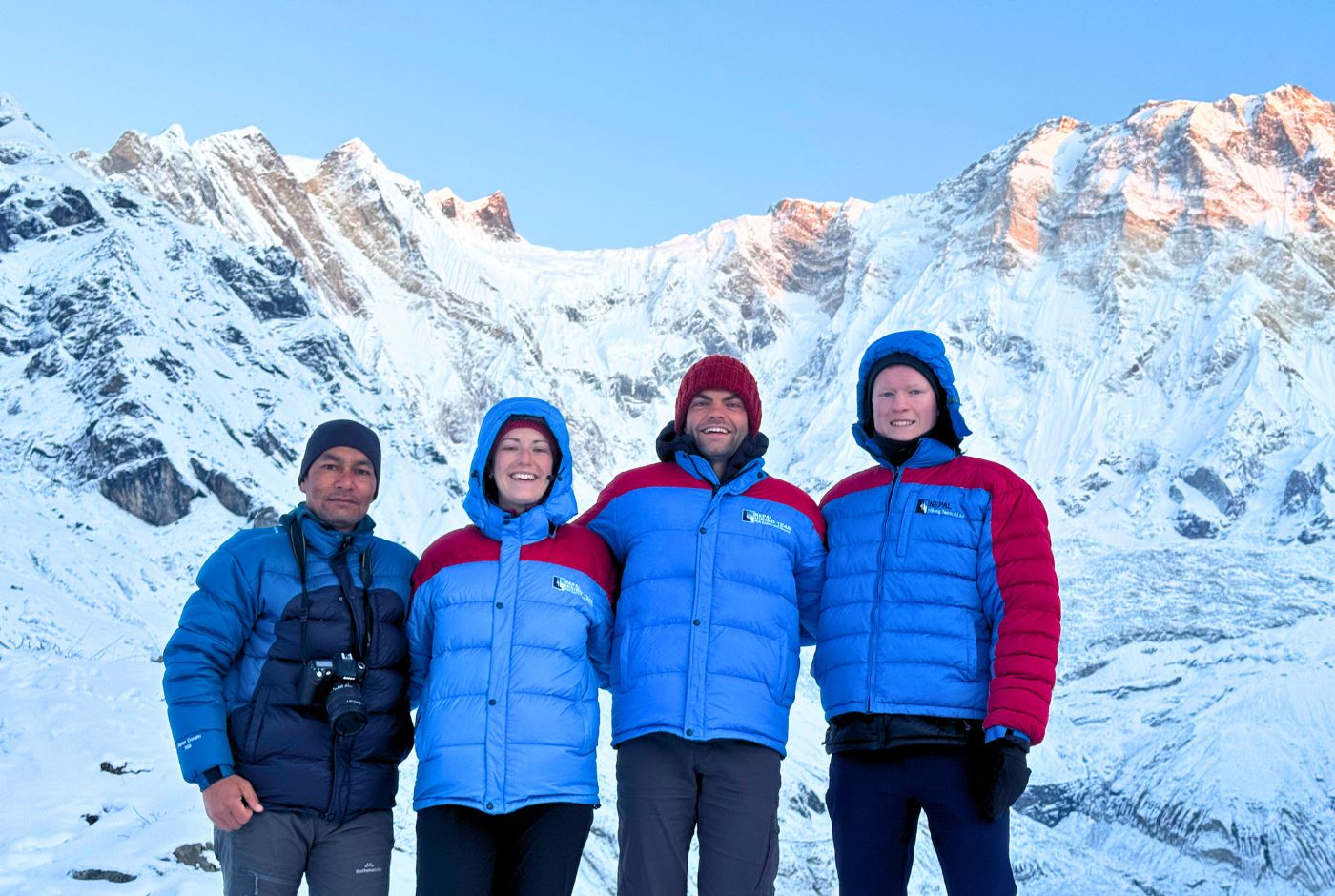
How to reach Annapurna Base Camp?
Reaching Pokhara – Gateway to Annapurna
From Kathmandu to Pokhara:
By Air: A short 30-minute domestic flight connects Tribhuvan International Airport (Kathmandu) to Pokhara Airport. Ideal for those with limited time.
By Road: A tourist bus, hire a taaxi or private vehicle takes about 7–8 hours, offering scenic views along the Prithvi Highway.
Why Pokhara? Pokhara is the launchpad for treks in the Annapurna region. It's also a great place to acclimate, pick up last-minute gear, and enjoy lakeside views before the journey begins.
The drive from Pokhara to Tikhedunga takes around 2 hours, while the drive to Kande takes about an hour. Each day's trek lasts for 5 to 7 hours. There are some steep ascents and descents en route and lots of stair climbing. None of these need technical skills.
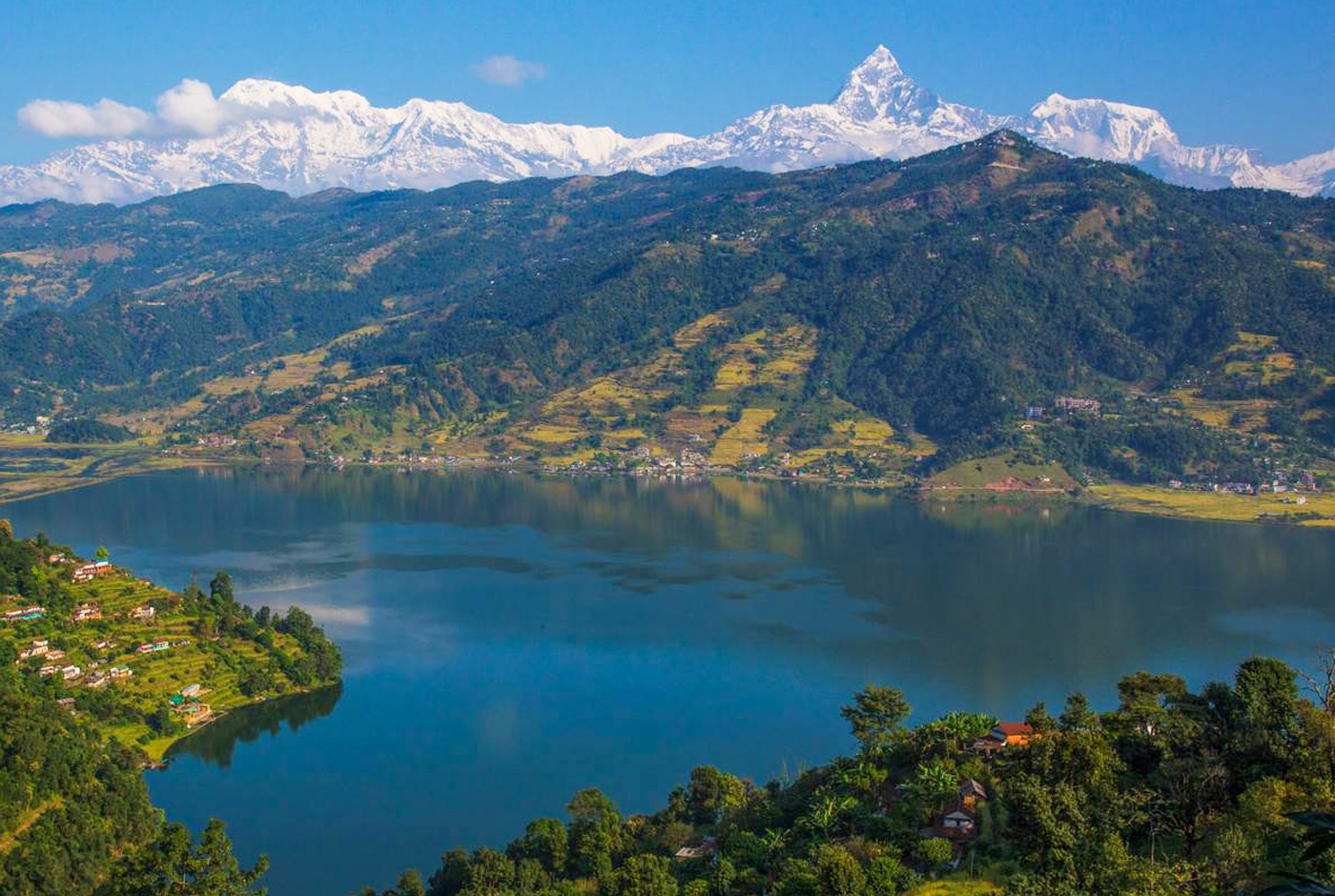
Trek Starting Points: Nayapul or Ghandruk
Option 1: Nayapul
- Drive Time from Pokhara: ~1.5 hours
- Trek Begins: From Nayapul (1,070m), passing Birethanti — a permit checkpoint and trail junction.
Option 2: Ghandruk
- Drive Time from Pokhara: ~3 hours
Why Ghandruk?
Starting from Ghandruk (1,940m) shortens the trek by a day and reduces initial ascents. Ideal for travelers preferring a less strenuous start.
Most tourists these days prefer to head directly to Ghandruk Village or Kimchi as the route from the village is the shortest to ABC. Depending on the condition of the road, it can take anywhere between 4 to 6 hours to reach Ghandruk from Pokhara.
How difficult is the Annapurna Base Camp Trek?
The Annapurna Base Camp trek difficulty is considered moderately challenging level, making it accessible to both first-time trekkers and those with prior experience. It requires a reasonable level of fitness, mental preparedness, and proper pacing. One of the key challenges is altitude, as the trail ascends to a maximum elevation of 4,130 meters (13,547 feet) at Annapurna Base Camp. At this height, trekkers may face symptoms of altitude sickness, so proper acclimatization and gradual ascent are essential.
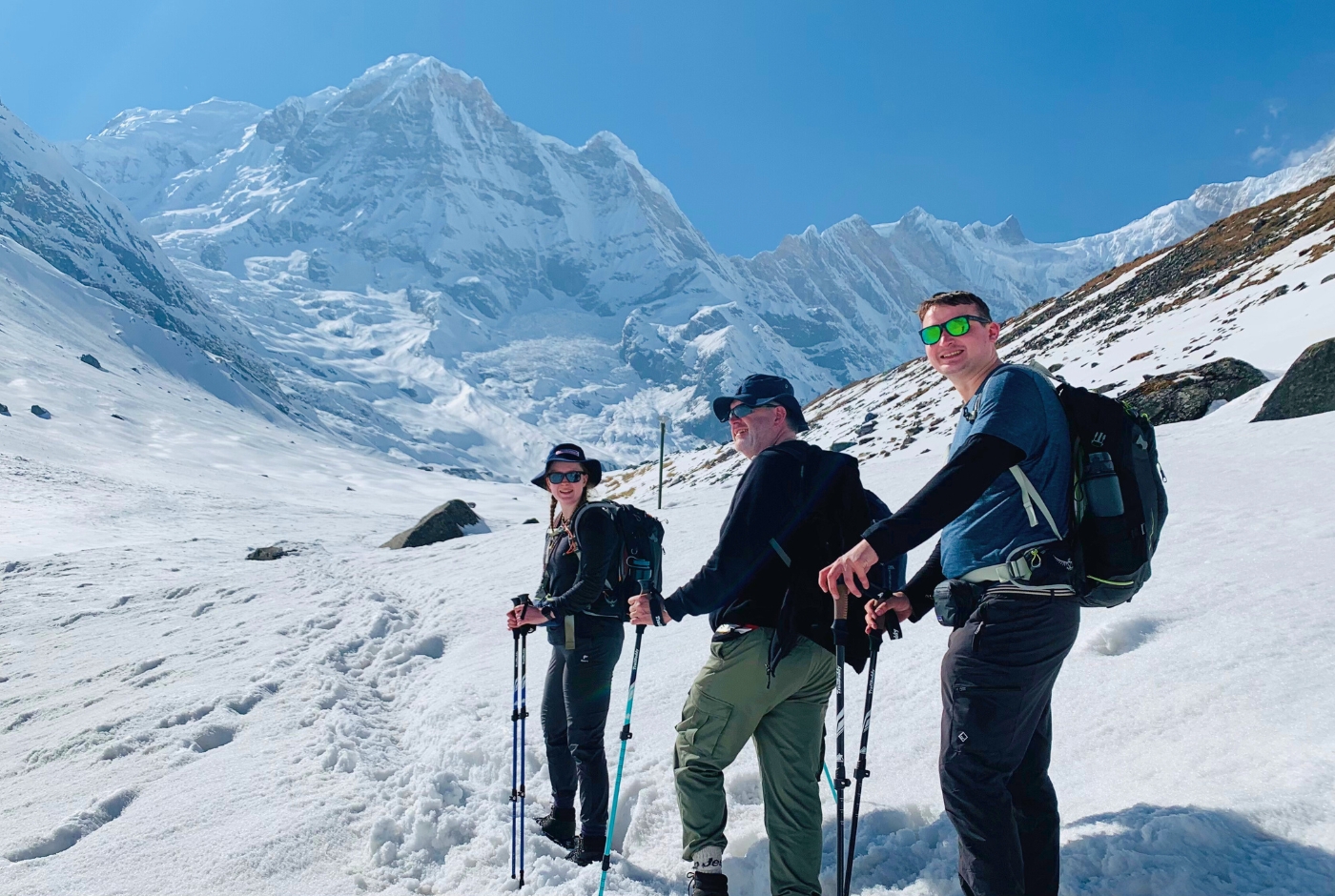
- Duration: Covering approximately 110 kilometers (68 miles), the trek typically takes 7 to 11 days, with daily hikes ranging from 5 to 7 hours.
- Terrain: The terrain is varied and includes steep ascents and descents, rocky paths, dense forests, and long stretches of stone staircases that demand stamina and endurance.
- Weather: Weather conditions can shift quickly, with the possibility of rain, snow, or extreme cold at higher elevations, adding an extra layer of difficulty. While the trek doesn’t require technical climbing skills, a solid fitness base helps significantly.
- Preparation: Preparing with regular hikes, especially on uneven terrain and while carrying a loaded backpack, can make the journey more comfortable.
- Guide and Porter: Hiring a guide and porter is highly recommended—not merely for safety and navigation but also to reduce physical strain and enhance cultural engagement along the way.
Permits: What permits are necessary for ABC Trek?
To undertake the Annapurna Base Camp (ABC) trek, securing the necessary permits is essential for both legal compliance and the preservation of the region's natural beauty. As of March 2025, the primary permit required is the Annapurna Conservation Area Permit (ACAP).
Annapurna Conservation Area Permit (ACAP):
Purpose: This permit grants access to the Annapurna Conservation Area, supporting conservation efforts and sustainable tourism initiatives within the region.
Cost:
- Foreign Nationals: NPR 3,000 per person (approximately USD 30).
- SAARC Nationals: NPR 1,000 per person (approximately USD 10).
Obtaining the ACAP: Trekkers can acquire the ACAP at the Nepal Tourism Board offices located in Kathmandu or Pokhara. To obtain this permit, you will need to provide a copy of your passport, two passport-sized photographs, and details of your trekking itinerary. It's advisable to carry the exact amount in Nepalese Rupees, as some offices may not accept other currencies or credit cards.
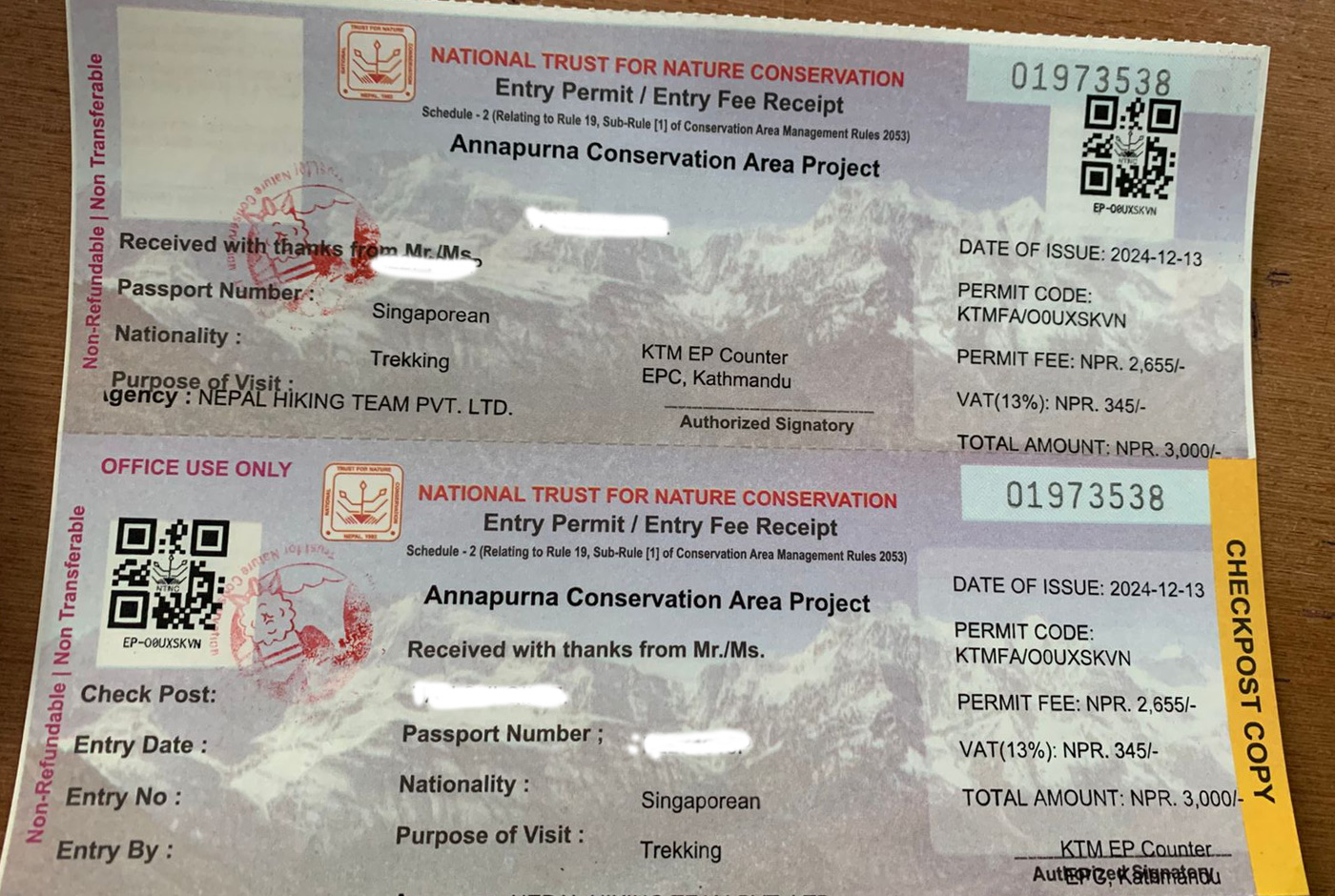
Trekkers' Information Management System (TIMS) Card:
Previously, the TIMS card was a mandatory requirement for trekkers in Nepal. However, as of April 1, 2023, the necessity for a TIMS card has been removed for the Annapurna region. Trekkers are no longer required to obtain this card for the ABC trek.
Important Considerations:
- Permit Verification: Ensure you keep your ACAP permit accessible, as you will need to present it at various checkpoints throughout the trek. Failure to produce a valid permit can result in fines or denial of entry beyond certain points.
- Guides and Porters: While not mandatory, hiring a licensed guide and/or porter can enhance your trekking experience, provide local insights, and assist in emergencies. Engaging local professionals also supports the local economy.
- Regulation Updates: Trekking regulations and permit requirements can change. It's recommended to verify the current requirements with official sources or through a reputable trekking agency before commencing your trek.
By obtaining the necessary permits and adhering to local regulations, you contribute to the conservation efforts and sustainable tourism practices that keep the Annapurna region pristine and welcoming for future trekkers.
Travel insurance for ABC Trek: What should it cover?
For travel insurance covering an Annapurna Base Camp trek guide, ensure it includes comprehensive medical coverage, emergency evacuation (including helicopter rescue), coverage for high-altitude trekking (above 5000 meters), and trip cancellation/interruption, plus other standard travel insurance benefits.
Medical Coverage:
- Altitude Sickness: The trek reaches elevations where altitude sickness can occur. Ensure your insurance covers treatment for this condition.
- Medical Expenses: Your policy should cover costs for doctor visits, hospital stays, and necessary medications during the trek.
Emergency Evacuation:
- Helicopter Rescue: In remote Himalayan regions, helicopter evacuation is often the quickest way to receive medical attention. Confirm that your insurance covers helicopter rescues up to 5,000 meters.
- Repatriation: Ensure your policy includes coverage for returning you to your home country or a suitable medical facility if necessary.
Trip Cancellation/Interruption:
- Unforeseen Events: Life is unpredictable. Your insurance should reimburse non-refundable expenses if your trip is canceled or cut short due to illness, injury, or other unexpected events.
Baggage and Personal Belongings:
- Trekking Gear: Trekking equipment is vital for your journey. Ensure your policy covers loss, theft, or damage to your gear.
Adventure Activities Coverage:
Trekking: Not all insurance policies cover adventure activities. Verify that trekking at high altitudes is included in your coverage.
Personal Liability:
Accidental Damage: Accidents can happen. Ensure your policy protects you if you're held responsible for injury or property damage during your trek.
Additional Considerations:
- Policy Limits: Some insurers have altitude restrictions. Ensure your policy covers trekking up to 6,000 meters to encompass the Annapurna Base Camp trek.
- Provider Recommendations: It's advisable to choose reputable insurance providers familiar with the requirements of high-altitude trekking in Nepal.
Having the right travel insurance ensures you can fully enjoy the breathtaking landscapes of the Annapurna region, knowing you're protected against potential challenges.
Best time to Trek Annapurna Base Camp
The best time to trek to Annapurna Base Camp is during the spring (March to May) and autumn (late September to November) seasons. These periods offer the most stable weather, clear skies, and comfortable temperatures, creating ideal conditions for a rewarding trekking experience.
Spring (March to May)
- Spring is a particularly vibrant and popular season for the Annapurna Base Camp trek.
- The weather during this time is generally pleasant, with warm days and cool nights. Rain and snowfall are rare, ensuring dry, stable trails that are easier to complete.
- One of spring’s most captivating features is the explosion of color in the rhododendron forests, which come alive in full bloom.
- As you trek through the region, you'll be surrounded by lush greenery, colorful blossoms, and panoramic views of the Annapurna range under crisp, clear skies. The visibility is excellent, making it a perfect season for mountain photography.
- Spring of Nepal also coincides with several cultural events, such as Nepal's New Year and Chaitra Dashain, giving trekkers a chance to witness local traditions along the route.
- However, due to its popularity, spring can be quite busy, especially on the more accessible sections of the trail.

Annapurna Base Camp Trek Review during Spring
No words or photos can describe the trekking to Annapurna Base Camp and back. It was awesome, it was incredibly hard, and it was mind-blowingly beautiful. The trek was amazing and I loved the slippery slopes coming down from Machhapuchhre Base Camp. Read more
Aututmn (September - November)
- Autumn, particularly from late September through November, is another outstanding time to undertake the trek. Following the summer monsoon, the air is fresh, clean, and free of dust, offering crystal-clear views of the Himalayas.
- Temperatures during the day are comfortably warm, while nights are cool but not harsh. Like spring, rainfall is minimal, keeping the trails dry and making for safer and more enjoyable trekking conditions.
- Although the natural scenery is less floral than in spring, autumn has its own charm, with golden-hued forests, ripening crops, and sweeping mountain vistas.
- The season is also rich in cultural experiences, with Nepal’s two major festivals—Dashain and Tihar—celebrated during this time. These festivals provide unique insight into local life and traditions, adding a cultural dimension to your journey.
- Autumn is also a peak trekking season, so while the trails are well-maintained and the teahouses open and prepared, expect to share the path with many fellow adventurers.
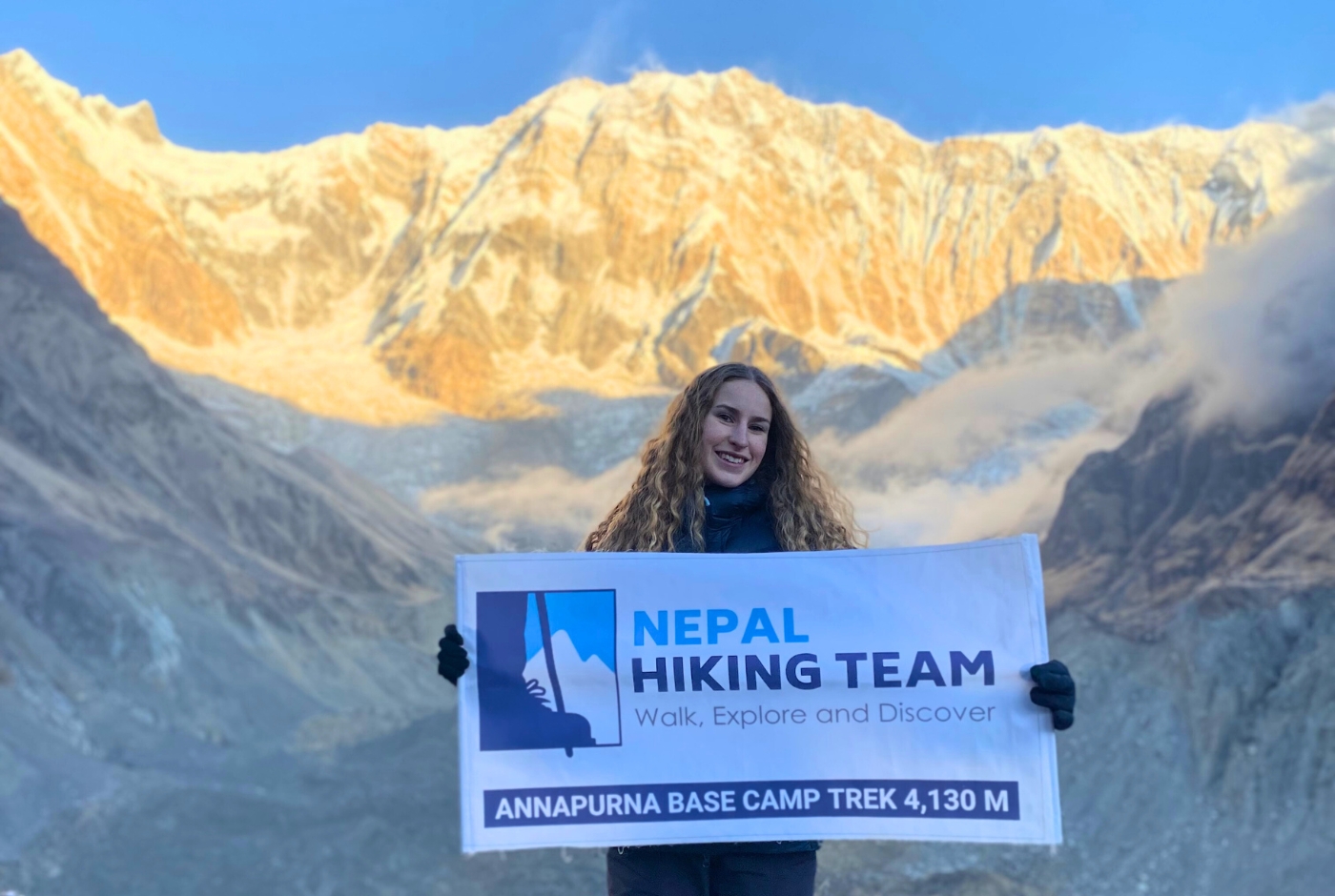
Annapurna Base Camp Trek Review during Autumn
I completed the Annapurna Base Camp Short Trek with Nepal Hiking Team in October this year. I joined with my friend, who had used Nepal Hiking Team before and highly recommended them. Their service lived up to the praise. Read More
When to Avoid? And Why?
The Annapurna Base Camp trek is best avoided during the winter (December to February) and monsoon (June to August) seasons due to challenging and potentially dangerous conditions. These periods bring harsh weather that significantly affects trail safety, visibility, and overall trekking experience.
Winter
- Winter conditions can be severe, particularly at higher altitudes.
- Temperatures often drop well below freezing, increasing the risk of frostbite and hypothermia.
- Snowfall is common and can quickly cover trails, making them difficult to follow and raising the likelihood of slips and injuries. In some areas, snow accumulation also increases the risk of avalanches, especially where slopes are unstable.
- Additionally, many lodges and teahouses close for the season, limiting access to essential services such as food, shelter, and emergency support.
- For these reasons, winter trekking in the Annapurna region requires specialist equipment and experience, and it remains unsuitable for most travelers.
Monsoon
- Monsoon brings its own set of difficulties.
- Torrential rainfall often leads to muddy and slippery trails, which can be hazardous even for experienced trekkers.
- Landslides are a common occurrence during this time, especially in areas with steep terrain and unstable soil.
- These can block paths, damage infrastructure, and pose serious safety risks. Persistent cloud cover and heavy rain frequently obscure mountain views, and trail conditions can shift quickly.
- The increased presence of leeches and insects during the wet season also adds discomfort. Travel disruptions are frequent, as flights to and from regional airports may be delayed or cancelled due to poor weather, complicating itineraries and logistics.
Trek Itinerary & Duration:
The Annapurna Base Camp trek is a widely favored Himalayan journey that typically spans 7 to 12 days, starting and ending in Pokhara. The trek takes you through terraced farmlands, dense rhododendron forests, and traditional Gurung and Magar villages before reaching the iconic Machhapuchhre Base Camp (MBC) and the breathtaking Annapurna Base Camp (ABC).
Most treks begin with a scenic drive from Pokhara to Nayapul or Jhinu, followed by daily hikes through varied terrain and elevations. The route offers a mix of cultural immersion and natural beauty, with panoramic views of Annapurna I, Hiunchuli, Machhapuchhre, and other towering peaks along the way.
Sample 7-Day Itinerary
- Day 1: Drive from Pokhara to Nayapul (or Jhinu), trek to Ghandruk or Chhomrong
- Day 2: Trek to Chhomrong (if starting from Ghandruk) or continue to Sinuwa
- Day 3: Trek to Bamboo or Deurali
- Day 4: Trek to Machhapuchhre Base Camp (MBC)
- Day 5: Hike to Annapurna Base Camp (ABC), then return to Bamboo
- Day 6: Trek back to Jhinu (or Chhomrong)
- Day 7: Trek to Nayapul, drive back to Pokhara
Shortest ABC Trek Itinerary
- Day 01: Drive from Pokhara – Nayapul – Jhinu - Trek to Sinuwa
- Day 02: Sinuwa – Bamboo – Deurali
- Day 03: Deurali – Machhapurchhe Base Camp – Annapurna Base Camp
- Day 04: ABC – MBC – Deurari – Bamboo
- Day 05: Bamboo – Choomrung – Jhinu, then Drive to Pokhara.
Alternative Itineraries
10–12 Day Itinerary:
Incorporates a detour via Ghorepani and Poon Hill, offering stunning sunrise views and better acclimatization. This version is ideal for those who prefer a slower pace or wish to extend their trekking experience with added cultural and scenic value.
5-Day Itinerary:
Designed for travelers with limited time, this condensed route focuses on key highlights and follows a more direct trail to ABC, with fewer stops and longer daily walks.
13-15 Day Itinerary:
This 13–15 day itinerary is specially designed for seniors and children who prefer a slower pace, shorter walking hours, and ample time for rest and acclimatization.
Customized Itineraries:
As a leading local operator, Nepal Hiking Team offers flexible trekking plans tailored to different fitness levels, schedules, and interests. Whether you're seeking a relaxed pace, a photography-focused trek, or a more challenging route, we ensure every itinerary delivers a meaningful experience.
Cost:
The cost of an Annapurna Base Camp trek typically ranges from $600 to $2,500+ per person, depending on key factors such as trip length, time of year, service level, and trekking style. Here's a concise breakdown to help you plan and budget effectively:
Factors Affecting Cost of ABC Trek
- Duration: Longer treks cost more due to additional accommodation, food, and guiding days.
- Season: Prices rise in peak trekking months (March–May, September–November) due to higher demand.
- Accommodation: Choices range from budget teahouses to higher-end hotels in Pokhara.
- Transportation: Flights or private vehicles to/from Pokhara and trailheads add to the overall cost.
- Services Included: Guided tours with porters, permits, meals, and equipment rentals increase the package price.
- Trekking Agency: Rates vary based on reputation, inclusions, and service quality.
Cost Breakdown
- Budget-Friendly Packages: $600 – $1,000
- Standard Packages: $1,000 – $1,500
- Luxury Treks: $2,000 – $2,500+
Flights to Pokhara (round trip): Around $200
- Permits: ACAP and TIMS permits (approximately $50–60 total)
- Guide & Porter: Adds value, safety, and comfort (approx. $25–35 per day combined)
- Equipment Rental: Sleeping bag/down jacket rental costs about $1.70 – $4.25 per item, per day
Tips for Budgeting
- Travel in Shoulder Season: April–May and October–November offer good weather with slightly lower rates.
- Join a Group Trek: Group packages reduce per-person costs and are ideal for solo trekkers.
- Bring Your Own Gear: Saves on daily rental expenses.
- Eat Local: Local tea houses and cafés offer cheaper meals than tourist-focused lodges.
- Negotiate: Many local agencies and accommodations are open to price discussions, especially off-season.
What to Pack?
For the Annapurna Base Camp trek, packing appropriately is essential for comfort, safety, and adaptability across changing altitudes and weather. Here’s a concise, well-organized checklist to help you prepare effectively:
Clothing
- Base Layers: Moisture-wicking long-sleeved shirts and trekking pants
- Insulation: Fleece jacket or sweater; down or puffer jacket for warmth at higher altitudes
- Outerwear: Waterproof, windproof jacket and pants for rain and snow protection
- Headwear: Sun hat or wide-brimmed hat; warm beanie for cold evenings
- Handwear: Lightweight gloves for daytime; insulated gloves or mittens for colder temperatures
- Footwear: Sturdy, well-broken-in hiking boots; multiple pairs of breathable, quick-drying hiking socks
- Underwear: Quick-drying, comfortable underwear (multiple pairs recommended)
- Other Essentials: Scarf, neck gaiter, or bandana for warmth and dust protection
Trekking Equipment
- Backpack: 30–40L for day use with comfortable straps and a rain cover
- Sleeping Bag: Rated for sub-zero temperatures (–10°C to –15°C recommended)
- Trekking Poles: Adjustable poles to reduce knee strain, especially on descents
- Headlamp: With spare batteries for use in lodges or early morning starts
- Water System: Water bottle or hydration bladder; purification tablets or a filter
- Rain Gear: Lightweight waterproof jacket and pants, even in dry seasons
- Duffel Bag: For porters to carry your main gear (usually provided on guided treks)
Accessories & Toiletries
- Sunglasses: UV protection for high-altitude glare
- Sunscreen & Lip Balm: High SPF to protect against sun exposure
- First-Aid Kit: Include essentials like band-aids, painkillers, antiseptic, blister care, and altitude medication
- Toiletries: Travel-sized toothpaste, soap, wet wipes, toothbrush, quick-dry towel, and toilet paper
- Hand Sanitizer: Crucial for maintaining hygiene in areas with limited facilities
- Electronics: Camera, charger, power bank; solar chargers can be useful
- Cash (NPR): ATMs are only available in Pokhara—bring enough for the entire trek
- Documents: Passport, insurance copy, ACAP and TIMS permits, and a few passport photos
Optional Items
- Binoculars for wildlife and mountain viewing
- Lightweight book, journal, or cards for downtime
- Energy bars or trail snacks
- Earplugs (lodges can be noisy)
Accommodation and Food
There are clean and comfortable lodges and teahouses run by locals along the trail. The rooms usually have twin beds with mattresses, pillows, and blankets. Some lodges offer rooms with attached bathrooms. Every teahouse has a common area with a stove in the middle where guests can dine and socialize. Hot showers, wi-fi, and charging electronic devices costs extra money.
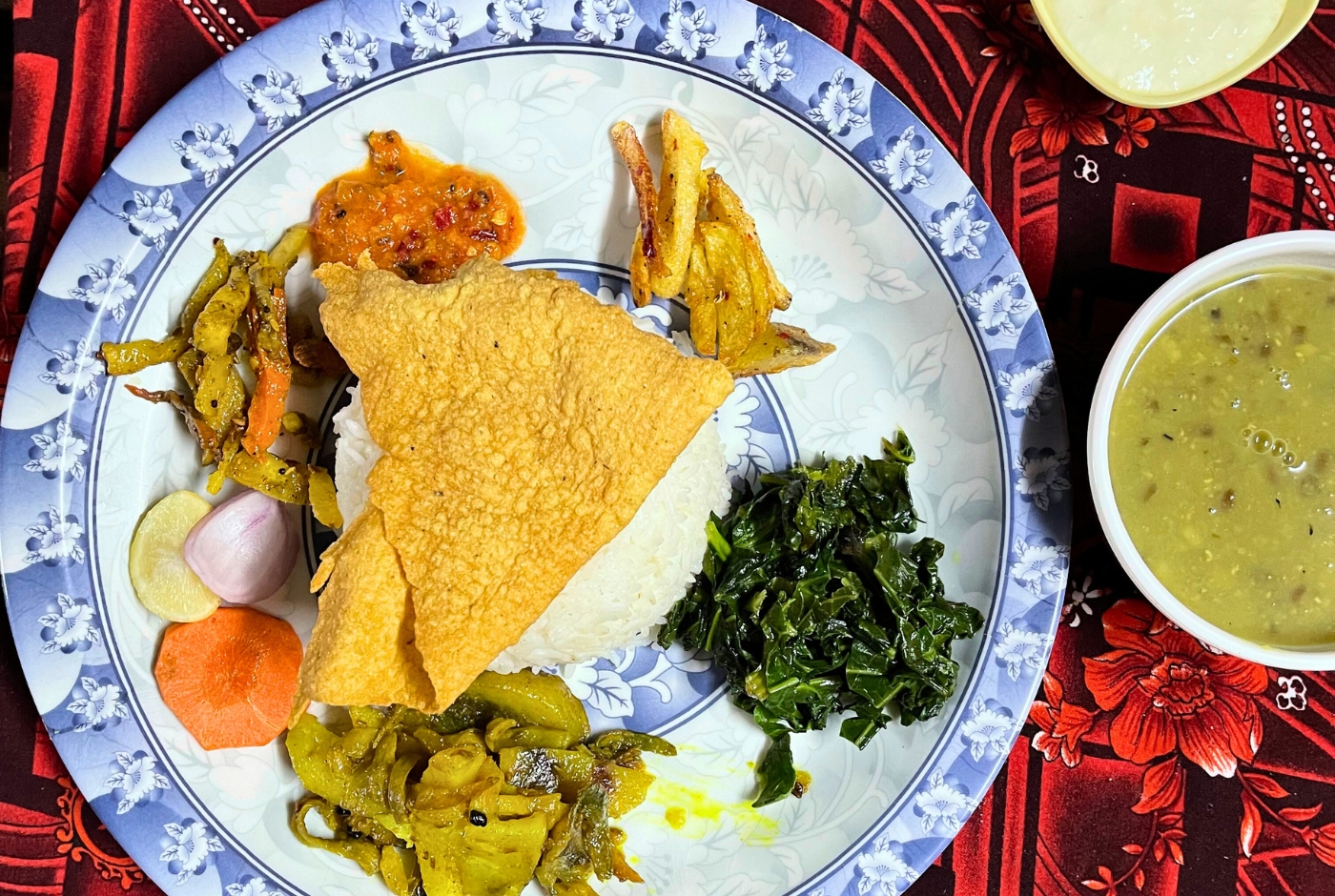
Since the ABC trail is one of the oldest commercial trails in Nepal, the food available along this route is one of the best. Popular items include pizza, lasagna, noodles, macaroni, momo, different types of bread, dal-bhaat (rice, lentils, and curry), etc.
Cultural Experiences:
During the Annapurna Base Camp trek, cultural immersion is as much a part of the journey as the mountain views. As you pass through traditional villages, you'll encounter the rich heritage of the Gurung, Magar, and Thakali communities—each offering distinct customs, lifestyles, and hospitality that bring the region to life.
Cultural Encounters Along the Route
- Ethnic Diversity: The trail weaves through villages where Gurung, Magar, and Thakali people have lived for generations. Their languages, dress, and customs give the trek a vibrant human dimension.
- Village Life: Daily routines like farming, weaving, and animal husbandry are part of what you’ll observe—and sometimes even participate in. These are not staged interactions, but real, lived experiences of remote Himalayan life.
- Traditional Architecture: Stone houses with slate roofs, prayer flags fluttering from rooftops, and narrow cobbled lanes reflect the architectural heritage of each village. It’s not uncommon to see Buddhist shrines and mani walls alongside Hindu shrines.
- Spiritual Landscape: Throughout the route, you'll pass prayer wheels, Buddhist stupas, and Hindu temples—symbols of Nepal’s spiritual blend. These cultural landmarks reflect the region’s reverence for nature, gods, and ancestral traditions.
- Local Cuisine: Savor traditional meals like dal bhat, gundruk, and homemade pickles. Many teahouses serve dishes prepared with locally sourced ingredients, offering an authentic taste of the hills.
- Festivals and Rituals: Depending on when you trek, you may witness local festivals such as Dashain, Tihar, or Maghe Sankranti. These events include rituals, music, dance, and communal feasts.
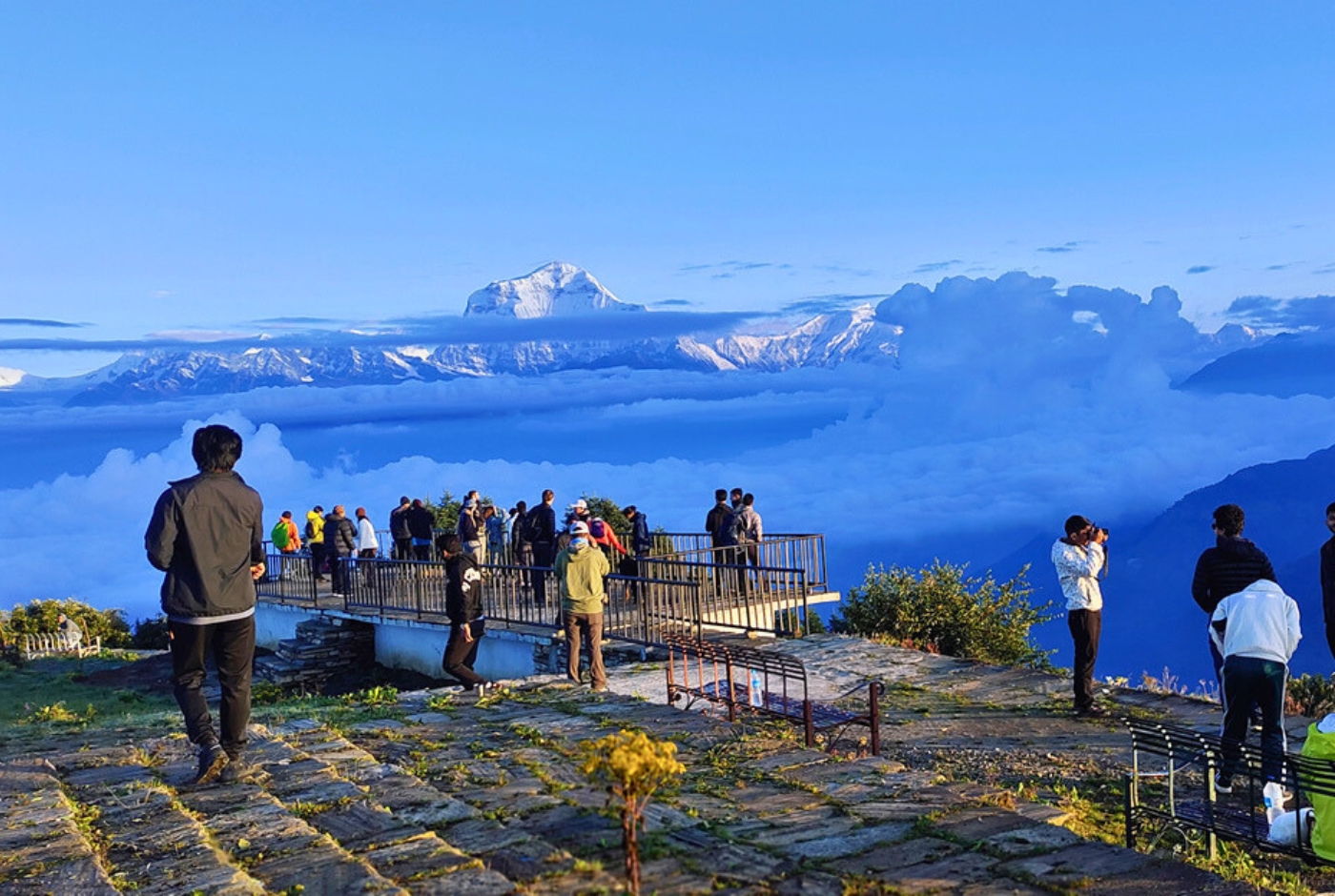
Specific Cultural Highlights
- Ghandruk: A major cultural stop, known for its strong Gurung identity. Visit the Gurung Museum, watch traditional dances, and explore homes built in classic style.
- Chhomrong: A Gurung village where trekkers often stay overnight, offering a relaxed chance to connect with locals and enjoy home-cooked meals.
- Jhinu Danda: Beyond its rejuvenating hot springs, Jhinu offers quiet village life and a friendly atmosphere ideal for cultural exchange.
- Poon Hill (optional route): While best known for its sunrise views, this stop also allows time in Ghorepani, a Magar village with cultural depth and hospitality.
- Annapurna Conservation Area Project (ACAP) Office: If passing through Ghandruk or other checkpoints, the ACAP office provides insight into local conservation efforts and community-based tourism initiatives.
Final Note
Annapurna Base Camp is the best trekking destination if you want to walk close to an 8000m mountain within a short duration. The trek introduces you to a typical Nepalese landscape – terraced fields, traditional villages, and forested hills. Children as young as eight years old and adults as old as seventy have been able to trek to ABC. The only criteria to complete this amazing trek is to have a fit body and strong determination.



